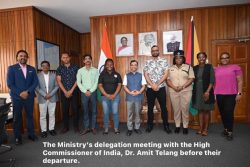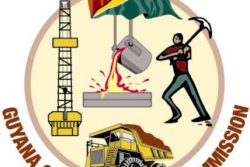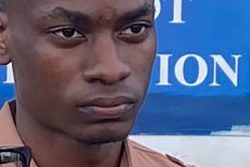 Inside Jamaica’s territorial sea, the nondescript 150-metre long container ship known as the MV “Asiatic Wind” made a sharp 90-degree turn and suddenly went dark for some 12 hours on June 3, last year.
Inside Jamaica’s territorial sea, the nondescript 150-metre long container ship known as the MV “Asiatic Wind” made a sharp 90-degree turn and suddenly went dark for some 12 hours on June 3, last year.
This means the vessel was not transmitting on its Automated Information Systems (AIS) during that time, a violation of international law, unless documented in the master’s log book, and sometimes an indicator, though inconclusive in this case, of suspicious activity, a maritime security expert says.
But the “Asiatic Wind” was carrying several containers of fine quality Guyana rice, including one unit identified, weeks later, with a stunning stash of 1.5 tons of neatly packaged cocaine, among the largest quantities ever seized in the northern German port city of Hamburg.
Reportedly following a tip-off, the authorities found the drug cache, with an estimated street value of around €300 million (US$353 million), hidden between sacks of rice in the container, in late June, local newspaper Hamburger Abendblatt reported that August.
In 2000, the International Maritime Organisation (IMO) adopted a requirement for all cargo vessels of 500 gross tonnage and up, to carry transponders capable of automatically providing information like position and identification, to other ships and to coastal authorities.
Flying the Singapore flag at the time, the German-owned ship with a unique IMO number 9366495, carried out mostly intra-Caribbean container transfers and was about to enter the Jamaican port of Kingston on June 3, 2020, having sailed as far south as Guyana. Earlier, on May 25, it had stopped for a day in Georgetown collecting inspected, fumigated and sealed containers with the cargo of local rice, transported by trucks to the capital from a top Berbice mill.
Spending a day or less at each port visit in Trinidad, Barbados and then Jamaica, the “Asiatic Wind” travelled on to Caucedo Andres, in the Dominican Republic where the rice consignment meant for FHU Konpack, a Polish import company was transferred on June 7.
Nearly a week on, the containers were moved to the “Jean Gabriel,” a Malta-flagged vessel built in 2018, and operated by the leading French marine transportation company, CMA CGM, for transhipment to Europe, where they remained in the Hamburg port.
In a detailed review published online in February this year, maritime law and security expert, Dr Ian Ralby questioned the accuracy and fairness of related media reports. None of the initial stories, particularly in the international media, clarified that “Jean Gabriel” was not the vessel that had picked up the rice from Guyana, he said. “Indeed, the media largely made it seem that ‘Jean Gabriel’ had, perhaps knowingly, taken the drugs from Guyana to Hamburg, and a number misreported that the drugs were found on the ship itself.” See article at https://cimsec.org/distinguishing-rice-from-wrong-important-lessons-from-the-hamburg-port-drug-bust-of-2020/
He noted, “Oddly, however, the ‘Jean Gabriel’ had not been to Guyana in 2020. In fact, since its construction it has never been to Guyana. Furthermore, the vessel was already on another voyage to South America by the time the drugs were discovered in Hamburg.” Drug trafficking in containerized cargo is increasing with a third of all such trafficking estimated to be transported in this manner. He argued that given 90 percent of world trade moves by sea, in many cases, the illegal cargo is loaded and unloaded like any legitimate container with cartels taking advantage of the infrastructure of global maritime commerce.
While the news stories around this case focused on the vessel that brought the subject container to Hamburg, “The real story is the voyage of the container, as that is how we can determine how the drugs actually got from wherever they originated, to Germany.” While there is nothing conclusive to indicate any connection between the vessel and the drug operation, he disclosed an “important concern” about part of the “Asiatic Wind’s” voyage.
Given the distance travelled from when that vessel went dark to where it reappeared, Windward Predictive Maritime Intelligence, “calculates that 11 hours and 36 minutes cannot be accounted for during that dark period. While it is unclear what happened in that interval, if investigators are unable to find a land- or port-based point of embarkation for the drugs, embarkment at sea is another possibility that cannot be ruled out without further examination.”
Based on the publicly available information, it is impossible in this particular case to determine where the drugs entered the container, he concluded. If the container was unsealed and resealed in the process of moving from Guyana to Hamburg, a process known as ‘rip-on, rip-off,’ “it would have required a sophisticated and likely quite noticeable operation, most likely in the Port of Caucedo. The container’s seal would have to be removed, the container opened and unpacked, the drugs inserted into the rice sacks, the container repacked, and a fraudulent seal fitted to avoid detection.”
The vessel tracks of the “Jean Gabriel” do not indicate any suspicious activity, he said, explaining that the change in draft from 11.7 meters to 12.1 meters between London and Hamburg, was “almost certainly caused by the change in buoyancy from salt water to fresh water.”
While the focus of the interdiction is on the cocaine and its supply chain, a wider law enforcement effort is needed to examine the relationship between benign goods and illicit activities to help ensure that even as drug cartels may use items like rice to obscure cocaine shipments, they do not end up controlling both the legitimate and illegitimate markets at the same time, he warned.
Days ago, a container with a shipment of 12-year-old rum originating from Guyana, was discovered in the Netherlands, with 1100 lbs of hidden cocaine, but local officials say checks before departure had revealed no contraband items.
The Chief Executive Officer of I.R. Consilium, a family firm that specialises in maritime and resource security, Dr Ralby stressed that criminality is a risk-reward calculus, questioning, “If Guyanese rice has been interdicted numerous times in the past with cocaine, yet it is still being used as a means of transporting cocaine, what does that say about how often it is successful?”
“Either the cartels are futilely making repeat attempts and hoping for a different result, or law enforcement is blind to the majority of what is moving. Businesses that don’t maintain a bottom line do not survive, so if the drug cartels are still using this tactic after a decade of sporadic interdictions, we have to assume that the majority of the time the criminals are successful.”
“ID learns that the “Asiatic Wind” has since been renamed the “CFS Wind” and is now flying a Cyprus flag. It remains a regional trade carrier having stopped in the Dominican Republic and most recently Guyana and Trinidad on its way to Jamaica.”







